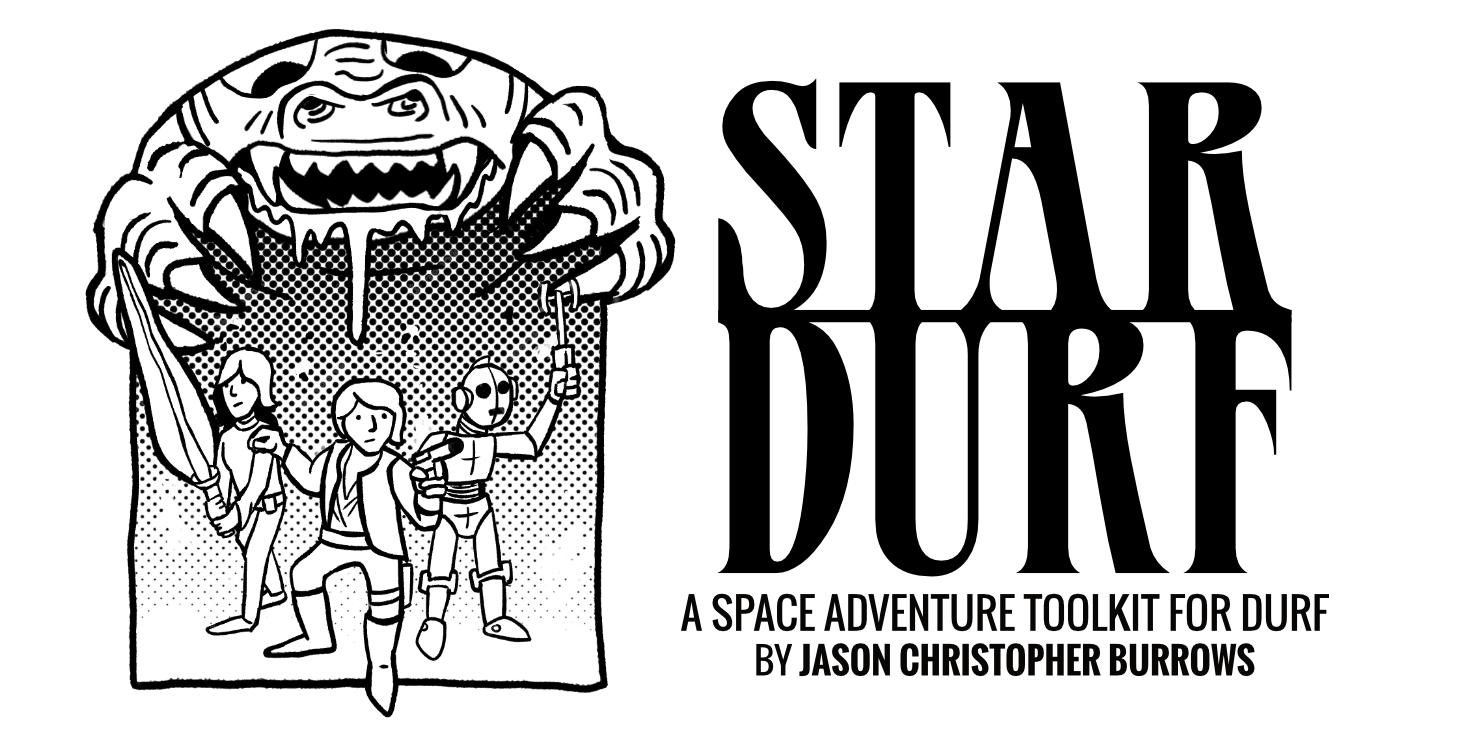Star System Generator
As part of the dungeon23 challenge I created a star system generator to quickly create simple star systems with interesting planets and points of interest.
If you are unaware, dungeon23 is a yearlong challenge in which you create a room or area of a megadungeon everyday. I have been creating an wandering astrodungeon comprised of a tiny exotic star surrounded by 3 ring worlds. You can check that out on my blog.
I wanted to post here about the star system generator. I'll be testing and expanding on it, as it will be incorporated into the upcoming standalone version of STAR DURF. I'm hoping to include faction, conflict, and civilisation generators to it.
Star System Generator
First, roll for the type of star system.
d20 Star System
- 1-4 Triple
- 5-13 Binary
- 14-20 Single
Binary star systems, where two stars orbit each other, are the most common in the galaxy. Triple star systems are the rarest.
For each star roll on the star type table.
d20 Star Type
- 1-5 Yellow Dwarf (young, small, bright)
- 6-9 Red Dwarf (young, small, dim)
- 10-12 Red Giant (old, large, dim)
- 13-14 Red Supergiant (old, massive, dim)
- 15-16 Blue Giant (very old, small, bright))
- 17-18 White Dwarf (very old, small, very bright)
- 19 Brown Dwarf ( very old, small, very dim)
- 20 Black Hole (ancient, large, dark with bright disc)
The star type shouldn't have too much of an impact on how things look on the system, but can make for interesting creative options. Yellow dwarf stars are young and therefor will have young planets with young societies. Red Supergiants have swelled up and probably destroyed a few inner planets. Brown dwarf stars are dim stars the cannot maintain nuclear fusion. Black holes won't emit light but may have a disc of hot gaseous matter around it that does.
Next are the planets. Star systems range wildly in the number of planets they can have. Roll a d20 to determine this.
For each planet roll on the planet type table.
d20 Planet Type
- 1-8 Rocky
- 9-13 Hospitable
- 14-16 Gas Giant
- 17-19 Ice Giant
- 20 Destroyed
Arrange the planets in any order. Usually the rocky and hospitable planets are closer to their star and the ice and gas giants are further away.
The galaxy is mostly filled with inhospitable planets devoid of life. Hospitable planets are similar to rocky ones but have an atmosphere and are usually more stable, thus they can support life.
For each hospitable planet roll on the number of biomes table.
d20 No. of Biomes
- 1-8 Single
- 9-15 Double
- 16-19 Triple
- 20 Earth-like
To keep hospitable planets simple they should have distinct planet-wide biomes. Rarer earth-likes with a huge variety of biomes are more realistic, but much more complex.
For each hospitable planet roll on the hospitable planet biomes table a number of times as indicated by the previous table. Earth-likes needn't be rolled for, as they have too many biomes.
d20 Hospitable Planet Biomes
- 1 Desert
- 2 Volcanic
- 3 Jungle
- 4 Grasslands
- 5 Ocean
- 6 Islands
- 7 Forest
- 8 Mountains
- 9 Steppes
- 10 Swamp
- 11 Snow
- 12 Fungal
- 13 Acidic
- 14 Savanah
- 15 Coral
- 16 Glacier
- 17 Canyons
- 18 Shrubland
- 19 Craterfield
- 20 Wasteland
The combination of biomes doesn't have to be realistic. Contrasting environments, such as desert and frozen, can have interesting explainations like the planet being in tidal lock. This makes a planet more memorable.
It should be determined which planets will have something noteworthy or interesting on them. Most planets don't need points of interest, but hospitable planets should have at least 1. Planets with a lot of activity should have at least 3 PoIs.
Roll on the planetary points of interest table.
d20 Planetary Points of Interest
- 1 Prison Colony
- 2 Mining Camp
- 3 Primitive Society
- 4 Ancient Temple
- 5 Factory Complex
- 6 Trade Hub
- 7 Military Outpost
- 8 Criminal Hive
- 9 Government Centre
- 10 Rebel Base
- 11 Agriculture Industry
- 12 Research Station
- 13 Leisure Facility
- 14 Scrap Field
- 15 Continental Megacity
- 16 Super Weapon
- 17 Corporate HQ
- 18 Starship Hanger
- 19 Power Plant
- 20 Bank Vault
These represent pretty broad concepts and are completely void of context. Thus they can be made far more interesting with a little bit of creativity. The scrap field can be a simple run-of-the-mill junkyard or it could be a starship graveyard left behind after a massive battle. The ancient temple can be the ruins of a long lost religion or a well maintained and active place of worship.
Besides planetary PoIs there are other objects in the system that can be of interest. Roll on the non-planetary object table.
d20 Non-planetary Object
- 1-4 None
- 5-7 Asteriod Belt
- 8-10 Dwarf Planet
- 11-13 Comet
- 14-15 Minefield
- 16-17 Space Station
- 18-19 Megastructure
- 20 Wormhole
Get STAR DURF
STAR DURF
A Space Adventure Toolkit for DURF
| Status | In development |
| Category | Physical game |
| Author | Jason Christopher Burrows |
| Genre | Adventure |
| Tags | durf, OSR, pen-and-paper, rules-lite, Sci-fi, Space, star-durf, Tabletop, Tabletop role-playing game |
More posts
- How to Forge ConstellationsFeb 18, 2025
- Progress and StarcrestsMar 05, 2023

Leave a comment
Log in with itch.io to leave a comment.